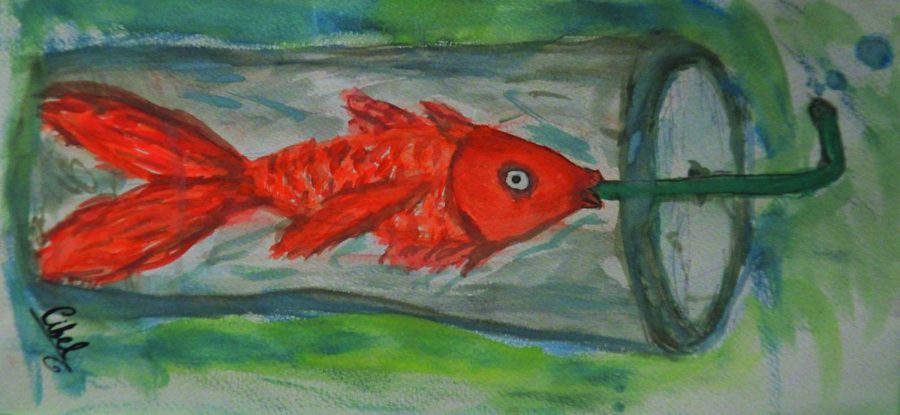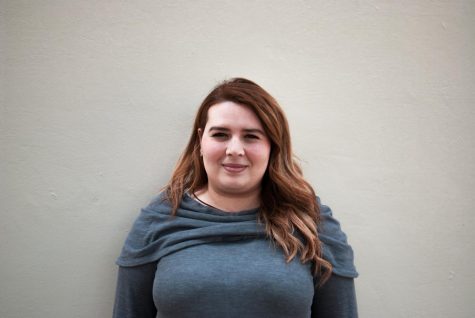Zero-Waste
It’s time to realize how much harmful waste goes in the ocean
Carmen Fernandez / Staff Illustrator
Too many creatures on the Earth are living with poisonous wastes.
Imagine carrying around four and a half pounds of garbage with you as you go about your day. We may not have to deal with the burden of our waste on our backs, but the Earth certainly does. The average American sends close to four and a half pounds of waste to landfills per day, which is almost two pounds more than any other nation’s average, according to the United States Environmental Protection Agency in 2013.
Analyzing these numbers may awake the indignation of many, but what is really appalling is picturing the deep and strong bonds we come to create with our daily four and a half pounds of trash throughout the course of our lives. Ties so fervent that the idea of a life without them shakes the reality of many. With that in mind, it is hard not to question how we got to this point as a society. We have managed to build and accept a culture in which the idea of generating no waste comes across as tedious, unnecessary and close to impossible.
A zero-waste lifestyle is often described as a philosophy that intends to redesign resource life cycles with the goal of sending no trash to landfills and incinerators, or producing absolutely no waste. A completely litter-less way of living may sound extreme, but so does the 8,300 tons of trash received daily by Sunshine Canyon Landfill. It is the same one that handles one-third of the waste produced in Los Angeles County, according to the Sunshine Canyon webpage.
Existing without harming the environment through excessive amounts of unnecessary plastic and other forms of waste is a challenge in the times of coffee cups, straws, travel-size toiletries and fast-fashion. Adopting a zero-waste philosophy is about much more than a list product restrictions. It’s more of a guide for connecting with the environment that surrounds us and our actions towards it. ”Every time we negatively impact the system we are jeopardizing our own ability to breath, drink water and consume food,” according to Bonny Bentizin, UCLA Deputy Chief Sustainability Officer. Our days are filled with a series of unconscious behaviors that shifts us away from understanding the impact of our consumption habits. We transport fruits and vegetables in thin plastic bags to the checkout points at the grocery stores, we support a market of single-use plastic water bottles when on average 46,000 pieces of plastic are swirling around in each square mile of our oceans according to The Plastic Bank.
There are alternatives, bar shampoo, refillable floss, second-hand shopping, reusable straws, mason jars, making your own makeup out of burnt almonds and beats, bamboo toothbrushes, paperless transactions, cloth napkins, using vinegar and baking soda as cleaning products, reusable cloth bags, containers and water bottles, composting, reusing and recycling are some of the elements often present in a litterless way of living.
Los Angeles counts with various resources for helping those desiring to be more conscious about the trash they are sending to landfill. There are dozens of farmer markets throughout the city, the closest one to Glendale located at Atwater Village, open Sundays from 10a.m. to 2p.m.. Offering a colorful variety of local farms produce, fresh eggs, artisan breads and dairy products as well as handmade essentials like bar soaps and candles. The Griffith Park Composting Facilities provides workshops Fridays and Saturdays on disposing of organic waste (egg shells, coffee grounds, paper napkins and towels, tea bags, vegetable peels and kitchen scraps) without the need of a garden. They also offer composting materials at bargain prices providing you with the knowledge and tools for ethically disposing “green waste” even as a citizen of a concrete jungle.
The City of Glendale offers a waste management system that categorizes waste into different color containers. Grey containers are exclusively for the recycling elements including: aluminum, tin, metal, food cartons, glass bottles and jars, plastic bottles, tubs and containers, carton and paper. All recycling must be rinsed and/or flatten. Surprisingly, plastic bags, coffee cups and Styrofoam are NOT considered recyclable materials and belong in the burgundy color containers, according to the City’s Guidelines for Automated Recycling and Trash Service.
Until legislature catches up with the miles of landfills and the oceans of plastic we can all take a zero-waste lifestyle as a guide in the horizon. We can all chose to take a step one less straw, one less coffee cup or one less produce bag at a time. The saying is that there’s a lot to tell from the contents of one man’s garbage bag. In today’s world, the size and existence of the same bag says a lot more about an individual.


